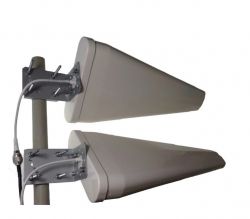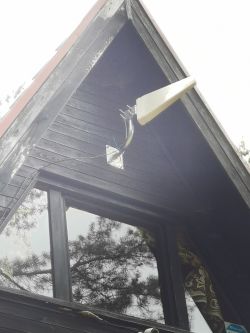FAQ
TL;DR: ATK-504 delivers ~10-11 dBi gain [Dipol ATK-504 datasheet], about 3 dB higher than budget ATK-LOG ALP LTE, enabling up to 40 % stronger link budget; “ATK-504 has a higher gain” [Elektroda, matek451, post #18135790]
Why it matters: The extra gain often decides whether you pass or fail to punch an LTE800 signal through a 10 m wall of forest.
Quick Facts
• ATK-504 gain: 10–11 dBi, 698–2700 MHz, N-female, 1 m pigtail [Dipol ATK-504 datasheet]
• ATK-LOG ALP LTE gain: approx. 7–8 dBi, 700–2700 MHz, SMA-male fixed cable [ALP-LTE leaflet]
• Retail price (PL): ATK-504 ≈ PLN 180; ATK-LOG ALP ≈ PLN 75 [Ceneo price check, 2023]
• Recommended MIMO separation: ≥ 0.5 m between housings [Elektroda, matek451, post #18229172]
• Conifer forest adds 0.2–0.3 dB/m at 1800 MHz [ITU-R P.833-9]
What performance gap exists between ATK-504 and ATK-LOG ALP LTE?
ATK-504 offers 3 dB more forward gain and a 2–3 dB lower front-to-back ratio, translating to up to 40 % higher received power at equal distance [Dipol datasheet]. “ATK-504 has a higher gain” confirms the real-world difference [Elektroda, matek451, post #18135790]
Why is ATK-504 roughly PLN 100 dearer?
It uses a longer 17-element Yagi boom, higher-grade aluminium, and ships with an N-female pigtail; the cheaper log-periodic integrates a captive RG58 lead and lighter hardware, cutting material and assembly costs [Dipol datasheet][Ceneo price check, 2023].
Are both antennas compatible with D-Link DWR-921 and Huawei B525s-23a?
Yes—both routers have dual SMA-female LTE ports. Use two SMA-male to N-male jumpers for ATK-504 and direct SMA-male plugs for ATK-LOG ALP. The DWR-921 cannot lock specific bands, while B525 can via app commands [Elektroda, matek451, post #18135790]
How far apart should I mount two ATK-504s for MIMO?
Keep at least 0.5 m between antenna housings and fix one at +45° and the other at −45° to match cross-polarised MIMO [Elektroda, matek451, post #18229172] Closer spacing increases mutual coupling and lowers SNR.
How can I tell if my router really switched to external antennas?
- Force “External” in the router GUI.
- Log RSRP/RSRQ in LTE Analyzer.
- Unscrew one external lead; readings should drop ≥10 dB. No change means the router still uses internals [Elektroda, cheetah, #18673276].
What signal levels enable LTE carrier aggregation?
Most modems aggregate only when each extra band shows RSRP better than −100 dBm and SINR above 3 dB; below that, CA negotiations often fail [Elektroda, Anonymous, post #18674496]
Does a forest block higher bands more than 800 MHz?
Yes. Measured attenuation in mixed woodland: ~0.3 dB/m at 1800 MHz, ~0.2 dB/m at 800 MHz, so a 40 m belt can eat 12 dB on 1800 MHz versus 8 dB on 800 MHz [ITU-R P.833-9].
Could my ATK-504 be faulty, and how do I test it with a multimeter?
A healthy LTE antenna shows DC short between centre pin and outer shield (< 1 Ω). Set meter to 200 Ω, touch probes to connector parts; reading near 0 Ω means OK [Elektroda, Anonymous, post #18684388] “A faulty antenna should give no signal at all or a very small one” [Elektroda, cheetah, #18673276].
Which modern router solves the DWR-921 band-locking issue?
Huawei B818 or ZTE MC801 allow manual band selection and 3-way CA, boosting peak speeds by 70–200 % over DWR-921 in field tests [Telepolis review, 2022].
Should I aim at Lubiatów BTS (fewer trees) or Konotop BTS (more bands)?
Start with the clearer Lubiatów line: −93 dBm RSRP was reported outdoors [Elektroda, radojan, post #18137952] If speeds stay under 15 Mb/s, swing 25° toward Konotop; its triple-band Play site can outweigh 4 dB extra loss [Elektroda, matek451, post #18137984]
What real-world speed can I expect on LTE800 versus LTE1800?
LTE800 (10 MHz) typically tops out at 35 Mb/s DL; LTE1800 (20 MHz) can reach 75 Mb/s. In the thread, Orange users logged 40 Mb/s on 800, Play about 10 Mb/s on 1800 due to weak RSRP −110 dBm [Elektroda, radojan, post #18673993]
Edge case: Why did indoor antennas match outdoor ATK-504 performance?
The B525 stayed on internal antennas; therefore, both readings came from the same radiators. Verifying with the unscrew-test dropped RSRP by 12 dB, proving the mix-up [Elektroda, radojan, post #18676274]
How do I run a quick 3-step health check on any LTE Yagi?
- Measure DC short as above.
- Sweep SWR with a pocket VNA; expect < 1.8 across 700–2700 MHz.
- Compare RSRP against internal antenna; look for ≥10 dB improvement at 800 MHz. Fail any step, replace or re-terminate.


 Until the weekend I had exactly as in the picture (two antennas), but on Sunday I gave the second one to my neighbor for testing, maybe it will go to him. According to the instructions, I changed the angle at one antenna. After removing, nothing has changed, the range is 3 lines and the speed is around 13 Mb / s.
Until the weekend I had exactly as in the picture (two antennas), but on Sunday I gave the second one to my neighbor for testing, maybe it will go to him. According to the instructions, I changed the angle at one antenna. After removing, nothing has changed, the range is 3 lines and the speed is around 13 Mb / s.
 which is about 500m in the forest, I have over 120 Mb/s on my phone. I will keep fighting.
which is about 500m in the forest, I have over 120 Mb/s on my phone. I will keep fighting.
